arduino uno r3学习笔记_u8glib库的使用
- 格式:docx
- 大小:17.88 KB
- 文档页数:1
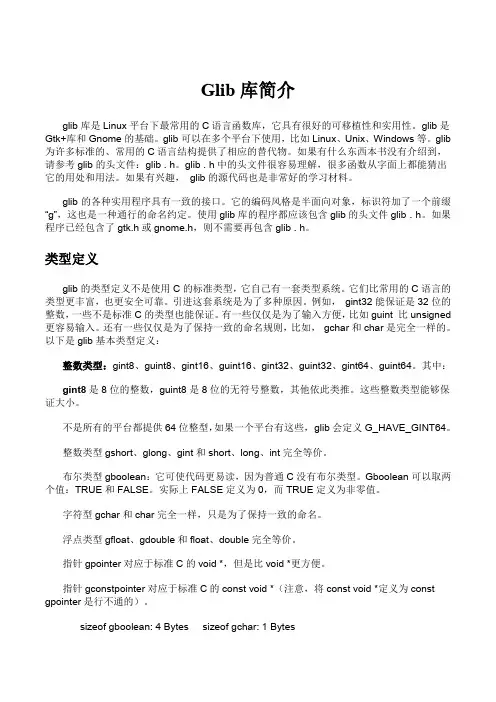
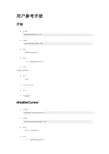
用户参考手册开始∙c++原型uint8_t U8GLIB::begin(void)∙C原型uint8_t u8g_Begin(u8g_t *u8g)∙描述重置显示和放到默认状态。
∙参数:o u8g u8g:指针结构(C接口)。
∙返回:0,如果初始化过程失败。
∙使用:外循环。
∙注意:与v1.11可用。
∙例子:∙disableCursor∙c++原型void U8GLIB::disableCursor(void)∙C原型void u8g_DisableCursor(u8g_t *u8g)∙描述禁用光标。
光标将不可见。
∙参数:o u8g u8g:指针结构(C接口)。
∙使用:外循环。
∙注意:∙例子:∙drawBitmapdrawBitmapP∙c++原型void U8GLIB::drawBitmap(u8g_uint_t x, u8g_uint_t y, u8g_uint_t cnt, u8g_uint_t h,const uint8_t *bitmap) void U8GLIB::drawBitmapP(u8g_uint_t x, u8g_uint_t y, u8g_uint_t cnt, u8g_uint_t h,const u8g_pgm_uint8_t *bitmap)∙C原型void u8g_DrawBitmap(u8g_t *u8g,u8g_uint_t x,u8g_uint_t y,u8g_uint_t cnt,u8g_uint_t h,const uint8_t *bitmap) void u8g_DrawBitmapP(u8g_t *u8g, u8g_uint_t x, u8g_uint_t y, u8g_uint_t cnt, u8g_uint_t h,constu8g_pgm_uint8_t *bitmap)∙描述绘制位图在指定的x / y位置(位图的左上角)。
外的部分位图可以显示边界。
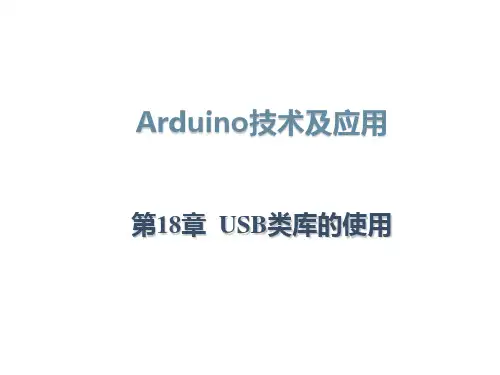
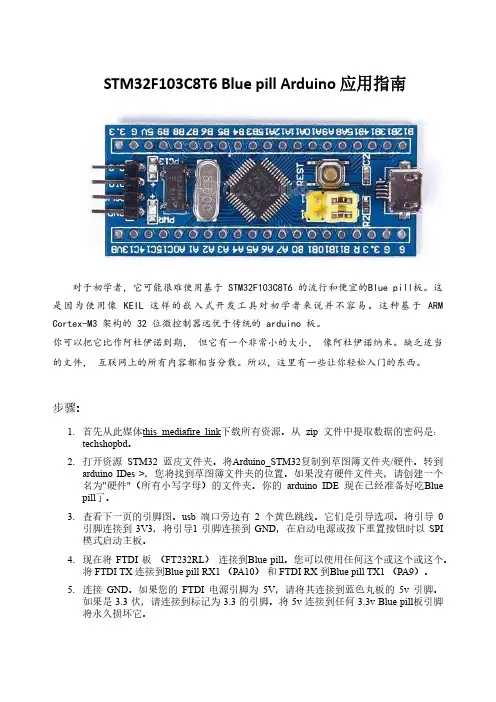
STM32F103C8T6 Blue pill Arduino应用指南对于初学者,它可能很难使用基于STM32F103C8T6的流行和便宜的Blue pill板。
这是因为使用像KEIL这样的嵌入式开发工具对初学者来说并不容易。
这种基于ARM Cortex-M3架构的32位微控制器远优于传统的arduino板。
你可以把它比作阿杜伊诺到期,但它有一个非常小的大小,像阿杜伊诺纳米。
缺乏适当的文件,互联网上的所有内容都相当分散。
所以,这里有一些让你轻松入门的东西。
步骤:1.首先从此媒体this mediafire link下载所有资源。
从zip文件中提取数据的密码是:techshopbd。
2.打开资源STM32蓝皮文件夹。
将Arduino_STM32复制到草图簿文件夹/硬件。
转到arduino IDes>,您将找到草图簿文件夹的位置。
如果没有硬件文件夹,请创建一个名为"硬件"(所有小写字母)的文件夹。
你的arduino IDE现在已经准备好吃Blue pill了。
3.查看下一页的引脚图。
usb端口旁边有2个黄色跳线。
它们是引导选项。
将引导0引脚连接到3V3,将引导1引脚连接到GND,在启动电源或按下重置按钮时以SPI 模式启动主板。
4.现在将FTDI板(FT232RL)连接到Blue pill。
您可以使用任何这个或这个或这个。
将FTDI TX连接到Blue pill RX1(PA10)和FTDI RX到Blue pill TX1(PA9)。
5.连接GND。
如果您的FTDI电源引脚为5V,请将其连接到蓝色丸板的5v引脚。
如果是3.3伏,请连接到标记为3.3的引脚。
将5v连接到任何3.3v Blue pill板引脚将永久损坏它。
6.使用USB端口将FTDI主板连接到您的PC。
您必须将FTDI驱动程序安装到PC才能使用FTDI板。
你会发现足够的资源在互联网上。
菲,是阿杜伊诺ꞏ纳诺的司机7.关闭arduino IDE,如果它是开放的。
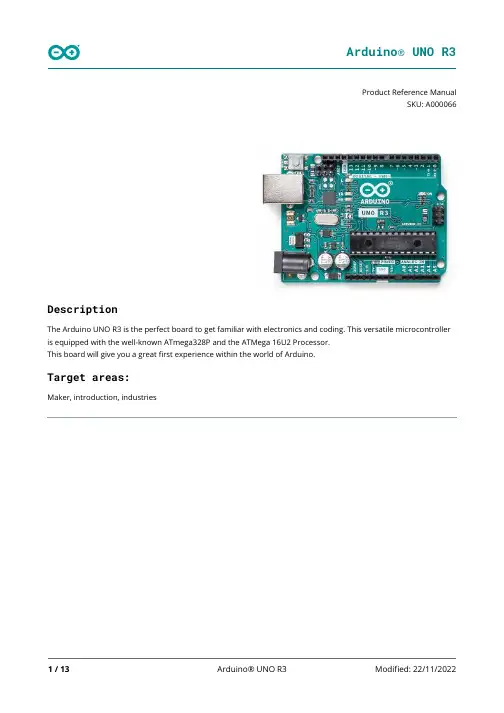
Product Reference ManualSKU: A000066DescriptionThe Arduino UNO R3 is the perfect board to get familiar with electronics and coding. This versatile microcontroller is equipped with the well-known ATmega328P and the ATMega 16U2 Processor.This board will give you a great first experience within the world of Arduino.Target areas:Maker, introduction, industriesFeaturesATMega328P ProcessorMemoryAVR CPU at up to 16 MHz32KB Flash2KB SRAM1KB EEPROMSecurityPower On Reset (POR)Brown Out Detection (BOD)Peripherals2x 8-bit Timer/Counter with a dedicated period register and compare channels1x 16-bit Timer/Counter with a dedicated period register, input capture and compare channels1x USART with fractional baud rate generator and start-of-frame detection1x controller/peripheral Serial Peripheral Interface (SPI)1x Dual mode controller/peripheral I2C1x Analog Comparator (AC) with a scalable reference inputWatchdog Timer with separate on-chip oscillatorSix PWM channelsInterrupt and wake-up on pin changeATMega16U2 Processor8-bit AVR® RISC-based microcontrollerMemory16 KB ISP Flash512B EEPROM512B SRAMdebugWIRE interface for on-chip debugging and programmingPower2.7-5.5 volts444445556677777789910101111111212131313CONTENTS1 The Board1.1 Application Examples 1.2 Related Products 2 Ratings2.1 Recommended Operating Conditions 2.2 Power Consumption 3 Functional Overview3.1 Board Topology 3.2 Processor 3.3 Power Tree 4 Board Operation4.1 Getting Started - IDE4.2 Getting Started - Arduino Web Editor 4.3 Getting Started - Arduino IoT Cloud 4.4 Sample Sketches 4.5 Online Resources 5 Connector Pinouts5.1 JANALOG 5.2 JDIGITAL5.3 Mechanical Information5.4 Board Outline & Mounting Holes 6 Certifications6.1 Declaration of Conformity CE DoC (EU)6.2 Declaration of Conformity to EU RoHS & REACH 211 01/19/20216.3 Conflict Minerals Declaration 7 FCC Caution8 Company Information 9 Reference Documentation 10 Revision History1 The Board1.1 Application ExamplesThe UNO board is the flagship product of Arduino. Regardless if you are new to the world of electronics or will use the UNO as a tool for education purposes or industry-related tasks.First entry to electronics: If this is your first project within coding and electronics, get started with our most used and documented board; Arduino UNO. It is equipped with the well-known ATmega328P processor, 14 digital input/output pins, 6 analog inputs, USB connections, ICSP header and reset button. This board includes everything you will need for a great first experience with Arduino.Industry-standard development board: Using the Arduino UNO board in industries, there are a range of companies using the UNO board as the brain for their PLC’s.Education purposes: Although the UNO board has been with us for about ten years, it is still widely used for various education purposes and scientific projects. The board's high standard and top quality performance makes it a great resource to capture real time from sensors and to trigger complex laboratory equipment to mention a few examples.1.2 Related ProductsStarter KitTinkerkit Braccio RobotExample2 Ratings2.1 Recommended Operating ConditionsSymbol Description Min Max Conservative thermal limits for the whole board:-40 °C (-40°F)85 °C ( 185°F) NOTE: In extreme temperatures, EEPROM, voltage regulator, and the crystal oscillator, might notwork as expected due to the extreme temperature conditions2.2 Power ConsumptionSymbol Description Min Typ Max Unit VINMax Maximum input voltage from VIN pad6-20V VUSBMax Maximum input voltage from USB connector- 5.5V PMax Maximum Power Consumption--xx mA 3 Functional Overview3.1 Board TopologyTop viewBoard topologyRef.Description Ref.DescriptionX1Power jack 2.1x5.5mm U1SPX1117M3-L-5 RegulatorX2USB B Connector U3ATMEGA16U2 ModulePC1EEE-1EA470WP 25V SMD Capacitor U5LMV358LIST-A.9 ICPC2EEE-1EA470WP 25V SMD Capacitor F1Chip Capacitor, High DensityD1CGRA4007-G Rectifier ICSP Pin header connector (through hole 6)J-ZU4ATMEGA328P Module ICSP1Pin header connector (through hole 6)Y1ECS-160-20-4X-DU Oscillator3.2 ProcessorThe Main Processor is a ATmega328P running at up tp 20 MHz. Most of its pins are connected to the external headers, however some are reserved for internal communication with the USB Bridge coprocessor.3.3 Power TreePower tree4 Board Operation4.1 Getting Started - IDEIf you want to program your Arduino UNO while offline you need to install the Arduino Desktop IDE [1] To connect the Arduino UNO to your computer, you’ll need a Micro-B USB cable. This also provides power to the board, as indicated by the LED.4.2 Getting Started - Arduino Web EditorAll Arduino boards, including this one, work out-of-the-box on the Arduino Web Editor [2], by just installing a simple plugin.The Arduino Web Editor is hosted online, therefore it will always be up-to-date with the latest features and support for all boards. Follow [3] to start coding on the browser and upload your sketches onto your board.4.3 Getting Started - Arduino IoT CloudAll Arduino IoT enabled products are supported on Arduino IoT Cloud which allows you to Log, graph and analyze sensor data, trigger events, and automate your home or business.4.4 Sample SketchesSample sketches for the Arduino XXX can be found either in the “Examples” menu in the Arduino IDE or in the “Documentation” section of the Arduino Pro website [4]4.5 Online ResourcesNow that you have gone through the basics of what you can do with the board you can explore the endless possibilities it provides by checking exciting projects on ProjectHub [5], the Arduino Library Reference [6] and the online store [7] where you will be able to complement your board with sensors, actuators and more5 Connector PinoutsPinout5.1 JANALOGPin Function Type Description1NC NC Not connected2IOREF IOREF Reference for digital logic V - connected to 5V 3Reset Reset Reset4+3V3Power+3V3 Power Rail5+5V Power+5V Power Rail6GND Power Ground7GND Power Ground8VIN Power Voltage Input9A0Analog/GPIO Analog input 0 /GPIO10A1Analog/GPIO Analog input 1 /GPIO11A2Analog/GPIO Analog input 2 /GPIO12A3Analog/GPIO Analog input 3 /GPIO13A4/SDA Analog input/I2C Analog input 4/I2C Data line14A5/SCL Analog input/I2C Analog input 5/I2C Clock line5.2 JDIGITALPin Function Type Description1D0Digital/GPIO Digital pin 0/GPIO2D1Digital/GPIO Digital pin 1/GPIO3D2Digital/GPIO Digital pin 2/GPIO4D3Digital/GPIO Digital pin 3/GPIO5D4Digital/GPIO Digital pin 4/GPIO6D5Digital/GPIO Digital pin 5/GPIO7D6Digital/GPIO Digital pin 6/GPIO8D7Digital/GPIO Digital pin 7/GPIO9D8Digital/GPIO Digital pin 8/GPIO10D9Digital/GPIO Digital pin 9/GPIO11SS Digital SPI Chip Select12MOSI Digital SPI1 Main Out Secondary In13MISO Digital SPI Main In Secondary Out14SCK Digital SPI serial clock output15GND Power Ground16AREF Digital Analog reference voltage17A4/SD4Digital Analog input 4/I2C Data line (duplicated)18A5/SD5Digital Analog input 5/I2C Clock line (duplicated)5.3 Mechanical Information5.4 Board Outline & Mounting HolesBoard outline6 Certifications6.1 Declaration of Conformity CE DoC (EU)We declare under our sole responsibility that the products above are in conformity with the essential requirements of the following EU Directives and therefore qualify for free movement within markets comprising the European Union (EU) and European Economic Area (EEA).ROHS 2 Directive 2011/65/EUConforms to:EN50581:2012Directive 2014/35/EU. (LVD)Conforms to:EN 60950-1:2006/A11:2009/A1:2010/A12:2011/AC:2011 Directive 2004/40/EC & 2008/46/EC & 2013/35/EU,EMFConforms to:EN 62311:20086.2 Declaration of Conformity to EU RoHS & REACH 211 01/19/2021Arduino boards are in compliance with RoHS 2 Directive 2011/65/EU of the European Parliament and RoHS 3 Directive 2015/863/EU of the Council of 4 June 2015 on the restriction of the use of certain hazardous substances in electrical and electronic equipment.Substance Maximum limit (ppm)Lead (Pb)1000Cadmium (Cd)100Mercury (Hg)1000Hexavalent Chromium (Cr6+)1000Poly Brominated Biphenyls (PBB)1000Poly Brominated Diphenyl ethers (PBDE)1000Bis(2-Ethylhexyl} phthalate (DEHP)1000Benzyl butyl phthalate (BBP)1000Dibutyl phthalate (DBP)1000Diisobutyl phthalate (DIBP)1000Exemptions: No exemptions are claimed.Arduino Boards are fully compliant with the related requirements of European Union Regulation (EC) 1907 /2006 concerning the Registration, Evaluation, Authorization and Restriction of Chemicals (REACH). We declare none of the SVHCs (https://echa.europa.eu/web/guest/candidate-list-table), the Candidate List of Substances of Very High Concern for authorization currently released by ECHA, is present in all products (and also package) in quantities totaling in a concentration equal or above 0.1%. To the best of our knowledge, we also declare that our products do not contain any of the substances listed on the "Authorization List" (Annex XIV of the REACH regulations) and Substances of Very High Concern (SVHC) in any significant amounts as specified by the Annex XVII of Candidate list published by ECHA (European Chemical Agency) 1907 /2006/EC.6.3 Conflict Minerals DeclarationAs a global supplier of electronic and electrical components, Arduino is aware of our obligations with regards to laws and regulations regarding Conflict Minerals, specifically the Dodd-Frank Wall Street Reform and Consumer Protection Act, Section 1502. Arduino does not directly source or process conflict minerals such as Tin, Tantalum, Tungsten, or Gold. Conflict minerals are contained in our products in the form of solder, or as a component in metal alloys. As part of our reasonable due diligence Arduino has contacted component suppliers within our supply chain to verify their continued compliance with the regulations. Based on the information received thus far we declare that our products contain Conflict Minerals sourced from conflict-free areas.7 FCC CautionAny Changes or modifications not expressly approved by the party responsible for compliance could void the user’s authority to operate the equipment.This device complies with part 15 of the FCC Rules. Operation is subject to the following two conditions:(1) This device may not cause harmful interference(2) this device must accept any interference received, including interference that may cause undesired operation. FCC RF Radiation Exposure Statement:1. This Transmitter must not be co-located or operating in conjunction with any other antenna or transmitter.2. This equipment complies with RF radiation exposure limits set forth for an uncontrolled environment.3. This equipment should be installed and operated with minimum distance 20cm between the radiator &your body.English: User manuals for license-exempt radio apparatus shall contain the following or equivalent notice in a conspicuous location in the user manual or alternatively on the device or both. This device complies with Industry Canada license-exempt RSS standard(s). Operation is subject to the following two conditions:(1) this device may not cause interference(2) this device must accept any interference, including interference that may cause undesired operation of the device.French: Le présent appareil est conforme aux CNR d’Industrie Canada applicables aux appareils radio exempts de licence. L’exploitation est autorisée aux deux conditions suivantes :(1) l’ appareil nedoit pas produire de brouillage(2) l’utilisateur de l’appareil doit accepter tout brouillage radioélectrique subi, même si le brouillage est susceptible d’en compromettre le fonctionnement.IC SAR Warning:English This equipment should be installed and operated with minimum distance 20 cm between the radiator and your body.French: Lors de l’ installation et de l’ exploitation de ce dispositif, la distance entre le radiateur et le corps est d ’au moins 20 cm.Important: The operating temperature of the EUT can’t exceed 85℃ and shouldn’t be lower than -40℃. Hereby, Arduino S.r.l. declares that this product is in compliance with essential requirements and other relevant provisions of Directive 2014/53/EU. This product is allowed to be used in all EU member states.8 Company InformationCompany name Arduino S.r.lCompany Address Via Andrea Appiani 25 20900 MONZA Italy9 Reference DocumentationReference LinkArduino IDE(Desktop)https:///en/Main/SoftwareArduino IDE (Cloud)https:///editorCloud IDE Getting Started https:///projecthub/Arduino_Genuino/getting-started-with-arduino-web-editor-4b3e4aArduino Pro Website https:///proProject Hub https:///projecthub?by=part&part_id=11332&sort=trending Library Reference https:///reference/en/Online Store https:///10 Revision HistoryDate Revision Changesxx/06/20211Datasheet release。
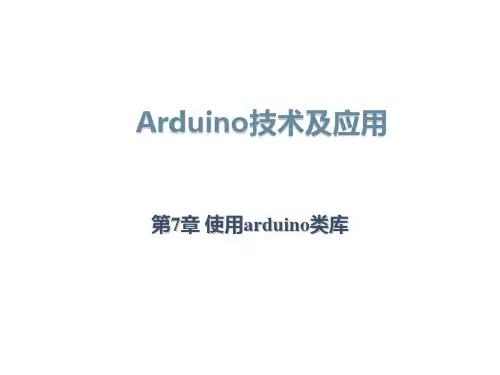
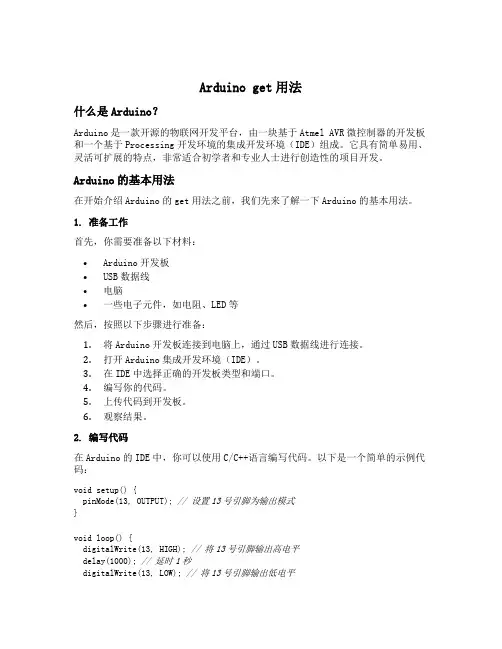
Arduino get用法什么是Arduino?Arduino是一款开源的物联网开发平台,由一块基于Atmel AVR微控制器的开发板和一个基于Processing开发环境的集成开发环境(IDE)组成。
它具有简单易用、灵活可扩展的特点,非常适合初学者和专业人士进行创造性的项目开发。
Arduino的基本用法在开始介绍Arduino的get用法之前,我们先来了解一下Arduino的基本用法。
1. 准备工作首先,你需要准备以下材料:•Arduino开发板•USB数据线•电脑•一些电子元件,如电阻、LED等然后,按照以下步骤进行准备:1.将Arduino开发板连接到电脑上,通过USB数据线进行连接。
2.打开Arduino集成开发环境(IDE)。
3.在IDE中选择正确的开发板类型和端口。
4.编写你的代码。
5.上传代码到开发板。
6.观察结果。
2. 编写代码在Arduino的IDE中,你可以使用C/C++语言编写代码。
以下是一个简单的示例代码:void setup() {pinMode(13, OUTPUT); // 设置13号引脚为输出模式}void loop() {digitalWrite(13, HIGH); // 将13号引脚输出高电平delay(1000); // 延时1秒digitalWrite(13, LOW); // 将13号引脚输出低电平delay(1000); // 延时1秒}上面的代码通过控制13号引脚的电平来控制一个LED的闪烁。
3. 上传代码当你编写好代码后,可以点击IDE界面上的“上传”按钮将代码上传到开发板上。
上传完成后,你就可以看到代码的执行结果了。
Arduino get用法Arduino的get用法指的是如何获取来自外部的输入信号,例如传感器数据、按钮状态等。
通过获取这些输入信号,你可以编写代码来实现各种功能。
1. 数字输入Arduino可以通过数字引脚来获取数字输入信号。
你可以使用digitalRead()函数来读取引脚的状态。
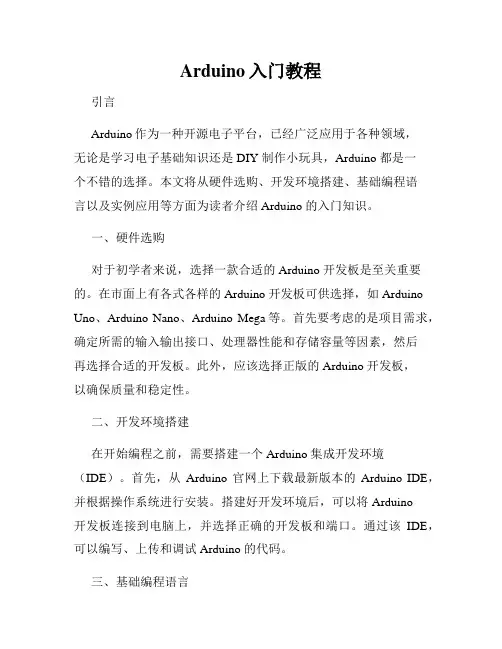
Arduino入门教程引言Arduino作为一种开源电子平台,已经广泛应用于各种领域,无论是学习电子基础知识还是 DIY 制作小玩具,Arduino 都是一个不错的选择。
本文将从硬件选购、开发环境搭建、基础编程语言以及实例应用等方面为读者介绍 Arduino 的入门知识。
一、硬件选购对于初学者来说,选择一款合适的 Arduino 开发板是至关重要的。
在市面上有各式各样的 Arduino 开发板可供选择,如 Arduino Uno、Arduino Nano、Arduino Mega等。
首先要考虑的是项目需求,确定所需的输入输出接口、处理器性能和存储容量等因素,然后再选择合适的开发板。
此外,应该选择正版的 Arduino 开发板,以确保质量和稳定性。
二、开发环境搭建在开始编程之前,需要搭建一个 Arduino 集成开发环境(IDE)。
首先,从Arduino 官网上下载最新版本的Arduino IDE,并根据操作系统进行安装。
搭建好开发环境后,可以将 Arduino开发板连接到电脑上,并选择正确的开发板和端口。
通过该IDE,可以编写、上传和调试 Arduino 的代码。
三、基础编程语言Arduino 的编程语言基于C/C++,但相对于传统的C/C++ 语言,Arduino 提供了更为简洁的函数库和接口,使得编程变得更加容易上手。
以下是一些基本语法和函数的介绍:1. 串口通信Arduino 通过串行通信口(Serial)与电脑进行通信。
通过使用Serial.begin() 函数来初始化串口,Serial.print() 和 Serial.println() 函数可用于向串口输出数据。
2. 控制结构Arduino 支持常见的控制结构,如 if 语句、for 循环和 while 循环等,这些控制结构可以用于条件判断和循环控制。
3. 数组和字符串Arduino 支持数组和字符串操作。
可以通过声明数组变量和使用 strcpy()、strcat() 等字符串函数进行操作。
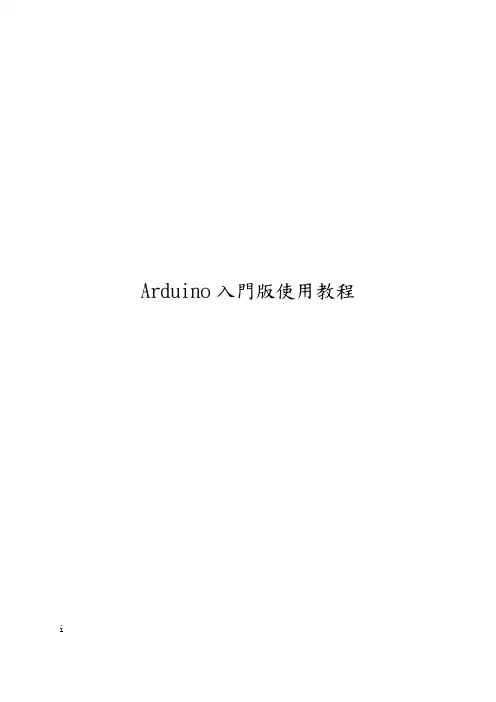
Arduino入門版使用教程i目錄介紹篇 ........................................................................ . (1)一、Arduino 基礎套裝介紹 (2)1、什麼是Arduino 基礎套裝? (2)2、元件清單 ........................................................................ (2)二、Arduino 介紹 ........................................................................ (4)1、什麼是Arduino? ................................................................. (4)2、特色描述 ........................................................................ (4)3、性能描述 ........................................................................ (4)三、Arduino C 語言介紹 ........................................................................ .. 61、關鍵字和符號 ........................................................................ .. (6)2、結構 ........................................................................ .. (9)3、功能 ........................................................................ (9)四、Arduino 使用介紹 ........................................................................ . (11)1、準備好你的Arduino板 (11)2、下載Arduino 開發環境 (13)3、安裝USB 驅動 ........................................................................ . (13)4、連接LED 燈電路 ........................................................................ .. (17)5、打開arduino 開發環境 (18)6、打開已有程式 ........................................................................ . (19)7、編譯程式 ........................................................................ . (20)8、下載程式 ........................................................................ . (23)五、麵包板使用介紹 ........................................................................ .. (30)1、麵包板介紹 ........................................................................ . (30)2、麵包板的使用 ........................................................................ (30)ii實驗篇 ........................................................................ .. (34)第一節多彩led 燈實驗 ........................................................................ .. 35一、發光二極管介紹 ........................................................................ .. (35)二、簡單的控制一個led 燈的閃爍實驗 (39)三、廣告燈效果實驗 ........................................................................ .. (41)第二節蜂鳴器實驗 ........................................................................ (48)一、蜂鳴器介紹 ........................................................................ .. (48)二、蜂鳴器模擬救護車警笛聲音實驗 (50)第三節數碼管實驗 ........................................................................ (54)一、數碼管介紹 ........................................................................ (54)二、數碼管顯示數字的實驗 (56)第四節按鍵實驗 ........................................................................ (63)一、按鍵介紹 ........................................................................ (63)二、按鍵控制led 等亮滅實驗 (65)三、擲骰子實驗 ........................................................................ (67)第五節傾斜開關實驗 ........................................................................ (74)一、傾斜開關介紹 ........................................................................ (74)二、傾斜開關控制led 燈的亮滅 (75)第六節光控聲音實驗 ........................................................................ (79)一、光敏電阻介紹 ........................................................................ (79)二、光控聲音實驗 ........................................................................ (80)第七節火焰報警實驗 ........................................................................ (84)一、火焰傳感器介紹 ........................................................................ (84)二、火焰報警實驗 ........................................................................ (85)第八節搶答器實驗 ........................................................................ (90)第九節溫度報警實驗 ........................................................................ (98)一、溫度傳感器介紹 ........................................................................ (98)iii二、溫度報警實驗 ........................................................................ (99)第十節紅外遙控 ........................................................................ . (103)一、紅外接收頭介紹 ........................................................................ . (103)二、紅外遙控實驗 ........................................................................ . (104)介紹篇一、Arduino 基礎套裝介紹1、什麼是Arduino基礎套裝?Arduino基礎套裝是精心為初學者設計的一款學習工具。
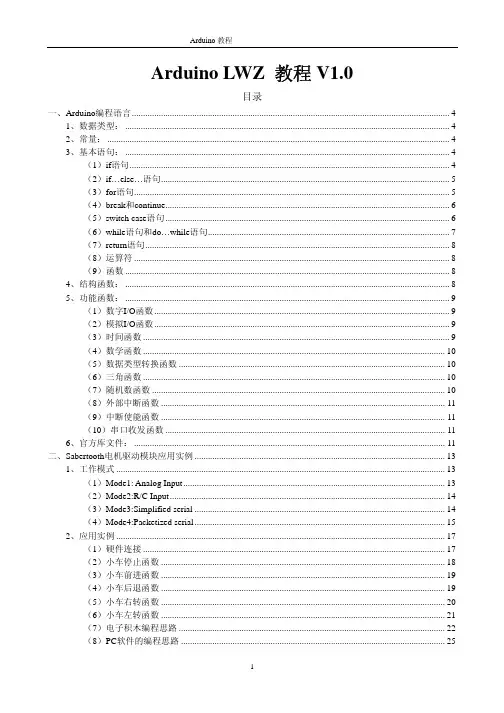
Arduino教程Arduino LWZ 教程V1.0目录一、Arduino编程语言 (4)1、数据类型: (4)2、常量: (4)3、基本语句: (4)(1)if语句 (4)(2)if...else...语句 (5)(3)for语句 (5)(4)break和continue (6)(5)switch case语句 (6)(6)while语句和do...while语句 (7)(7)return语句 (8)(8)运算符 (8)(9)函数 (8)4、结构函数: (8)5、功能函数: (9)(1)数字I/O函数 (9)(2)模拟I/O函数 (9)(3)时间函数 (9)(4)数学函数 (10)(5)数据类型转换函数 (10)(6)三角函数 (10)(7)随机数函数 (10)(8)外部中断函数 (11)(9)中断使能函数 (11)(10)串口收发函数 (11)6、官方库文件: (11)二、Sabertooth电机驱动模块应用实例 (13)1、工作模式 (13)(1)Mode1: Analog Input (13)(2)Mode2:R/C Input (14)(3)Mode3:Simplified serial (14)(4)Mode4:Packetized serial (15)2、应用实例 (17)(1)硬件连接 (17)(2)小车停止函数 (18)(3)小车前进函数 (19)(4)小车后退函数 (19)(5)小车右转函数 (20)(6)小车左转函数 (21)(7)电子积木编程思路 (22)(8)PC软件的编程思路 (25)(1)硬件连接 (25)(2)电子积木运动和初始化函数 (25)(3)电子积木编程思路 (26)4、通过无线模块控制小车 (28)(1)无线通信模块 (28)(2)硬件连接 (28)(3)电子积木编程思路 (28)5、下载程序串口COM和无线数模串口COM2同时控制小车 (30)(1)硬件连接 (31)(2)电子积木编程思路 (31)三、TN901_TEST非接触测温模块应用实例 (34)1、TN901工作原理 (34)2、应用实例 (36)(1)硬件连接 (36)(2)读取温度函数 (36)(3)初始化函数 (38)(4)电子积木编程思路 (38)3、多个TN模块的应用实例 (39)(1)硬件连接 (39)(2)初始化函数 (39)(3)电子积木编程思想:共享函数 (40)(4)电子积木编程思路:独立函数 (42)四、气体传感器模块应用实例 (46)1、应用实例 (46)(1)硬件连接 (46)(2)电子积木编程思路 (46)2、多个气体传感器的应用实例 (47)(1)硬件连接 (47)(2)电子积木编程思路 (47)五、火焰传感器模块应用实例 (48)1、应用实例 (48)(1)硬件连接 (48)(2)电子积木编程思路 (49)2、多个火焰传感器的应用实例 (49)(1)硬件连接 (49)(2)电子积木编程思路 (50)六、DF-miniLTV3寻线模块应用实例 (50)1、DF-miniLTV3寻线工作原理 (50)2、DF-miniLTV3寻线在单黑线的应用实例 (51)(1)硬件连接 (52)(2)Sabertooth模块函数 (52)(3)初始化函数 (52)(4)电子积木编程思路 (52)(1)硬件连接 (54)(2)电子积木编程思路 (54)(2)PC软件的编程思路 (56)七、舵机模块应用实例 (56)1、舵机工作原理 (56)2、应用实例 (57)(1)硬件连接 (57)(2)电子积木编程思路 (57)3、非库形式的应用实例 (59)(1)硬件连接 (59)(2)双舵机驱动函数 (59)八、综合实例 (63)1、驱动2台舵机和电机的应用实例 (63)(1)硬件连接 (63)(2)电子积木编程思路 (64)2、测3个测温度、驱动电机的应用实例 (64)(1)硬件连接 (64)(2)电子积木编程思路 (64)3、测3个测温度、驱动2台舵机和电机的应用实例 (65)(1)硬件连接 (65)(2)电子积木编程思路 (65)4、测2个气体、2个火焰、3个测温度、驱动2台舵机和电机的应用实例 (65)(1)硬件连接 (65)(2)电子积木编程思路 (65)5、寻线、测2个气体、2个火焰、3个测温度、驱动2台舵机和电机的应用实例 (66)(1)硬件连接 (66)(2)电子积木编程思路 (66)一、Arduino编程语言Arduino语言是建立在C/C++基础上的。
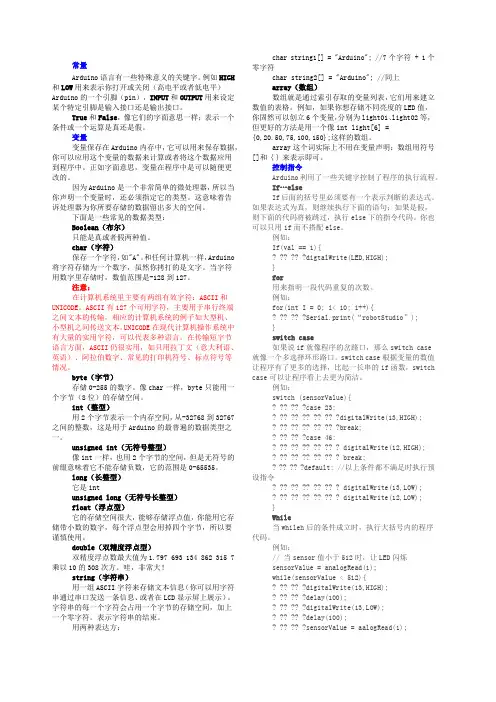
常量Arduino语言有一些特殊意义的关键字。
例如HIGH 和LOW用来表示你打开或关闭(高电平或者低电平)Arduino的一个引脚(pin),INPUT和OUTPUT用来设定某个特定引脚是输入接口还是输出接口。
True和False,像它们的字面意思一样;表示一个条件或一个运算是真还是假。
变量变量保存在Arduino内存中,它可以用来保存数据,你可以应用这个变量的数据来计算或者将这个数据应用到程序中。
正如字面意思,变量在程序中是可以随便更改的。
因为Arduino是一个非常简单的微处理器,所以当你声明一个变量时,还必须指定它的类型。
这意味着告诉处理器为你所要存储的数据留出多大的空间。
下面是一些常见的数据类型:Boolean(布尔)只能是真或者假两种值。
char(字符)保存一个字符,如"A"。
和任何计算机一样,Arduino 将字符存储为一个数字,虽然你拷打的是文字。
当字符用数字里存储时,数值范围是-128到127。
注意:在计算机系统里主要有两组有效字符:ASCII和UNICODE。
ASCII有127个可用字符,主要用于串行终端之间文本的传输,相应的计算机系统的例子如大型机、小型机之间传送文本。
UNICODE在现代计算机操作系统中有大量的实用字符,可以代表多种语言。
在传输短字节语言方面,ASCII仍很实用,如只用拉丁文(意大利语、英语)、阿拉伯数字、常见的打印机符号、标点符号等情况。
byte(字节)存储0-255的数字。
像char一样,byte只能用一个字节(8位)的存储空间。
int(整型)用2个字节表示一个内存空间,从-32768到32767之间的整数,这是用于Arduino的最普遍的数据类型之一。
unsigned int(无符号整型)像int一样,也用2个字节的空间,但是无符号的前缀意味着它不能存储负数,它的范围是0-65535。
long(长整型)它是intunsigned long(无符号长整型)float(浮点型)它的存储空间很大,能够存储浮点值,你能用它存储带小数的数字,每个浮点型会用掉四个字节,所以要谨慎使用。
arduino函数库中各个函数的用法
Arduino函数库是一组提供给用户使用的函数,用于简化编程的过程。
每个函数都有自己的用法和参数。
以下是几个常见的Arduino函数库及其用法的示例:
1. digitalWrite(pin, value):将指定的IO引脚设置为高电平或低电平。
使用示例:digitalWrite(13, HIGH); // 将引脚13设置为高电平
2. analogRead(pin):读取指定的模拟引脚上的电压值。
使用示例:int sensorValue = analogRead(A0); // 读取A0引脚上的电压值
3. Serial.begin(baudRate):初始化串口通信,并设置波特率。
使用示例:Serial.begin(9600); // 初始化串口通信,波特率为9600
4. delay(milliseconds):延迟指定的毫秒数。
使用示例:delay(1000); // 延迟1秒
5. pinMode(pin, mode):设置指定引脚的工作模式,可以为输入(INPUT)或输出(OUTPUT)。
使用示例:pinMode(7, OUTPUT); // 将引脚7设置为输出模式
6. tone(pin, frequency):在指定引脚上生成指定频率的方波。
使用示例:tone(9, 1000); // 在引脚9上生成1000Hz的方波
需要根据具体应用场景选择合适的函数,并根据函数说明传递正确的参数。
可以通过Arduino官方网站或其他资源查找更多函数的详细说明和示例代码。
Arduino参考手册Arduino开发语言提供全部的C语言特性和C++语言的部分特性. 通过链接到AVR的libc库online~, 可以使用库中提供的函数. 具体的应用细节请参考相关文档.程序结构在Arduino中, 标准的程序入口main函数在内部被定义, 用户只需要关心以下两个函数: ∙void setup()∙void loop()setup()函数用于初始化, loop()函数用于执行. 初始化函数一般放在程序开头, 用于设置一些引脚的输出/输入模式, 初始化串口通讯等类似工作. loop()函数中的代码将被循环执行, 例如: 读入引脚状态, 设置引脚输出状态等.控制语句∙if∙if...else∙for∙switch∙while∙do...while∙break∙continue∙return∙goto相关语法∙; (分号)∙{}(大括号)∙// (单行注释)∙/* * / (多行注释)∙#define∙#include算术运算符∙= (赋值)∙+ (加)∙- (减)∙* (乘)∙/ (除)∙% (取模)比较运算符∙== (等于)∙!= (不等于)∙< (小于)∙> (大于)∙<= (小于等于)∙>= (大于等于)布尔运算符∙&& (逻辑与)∙|| (逻辑或)∙! (逻辑非)指针运算符∙* 指针运算符∙& 地址运算符位运算∙& (位与)∙| (位或)∙^ (位异或)∙~ (位非)∙<< (左移)∙>> (右移)∙端口操作复合运算符∙++ (自加)∙-- (自减)∙+= (复合加)∙-= (复合减)∙*= (复合乘)∙/= (复合除)∙&= (复合与)∙|= (复合或)变量常量∙HIGH | LOW∙INPUT | OUTPUT∙true | false∙整数常量∙浮点数常量数据类型∙void(无类型)∙boolean(布尔型)∙char(字符型)∙unsigned char(无符号字符型)∙byte(字节型)∙int(整型)∙unsigned int(无符号整型)∙long(长整型)∙unsigned long(无符号长整型)∙float(单精度)∙double(双精度)∙string(字符串)∙array(数组)数据类型转换∙char()∙byte()∙int()∙word()∙long()∙float()变量作用域&修饰符∙变量作用域∙static (静态变量)∙volatile (易变变量)∙const (不可改变变量)辅助工具∙sizeof() (sizeof运算符)∙ASCII码表基本函数数字I/O∙pinMode(pin, mode)∙digitalWrite(pin, value)∙digitalRead(pin)模拟I/O∙analogReference(type)∙analogRead(pin)∙analogWrite(pin, value) - PWM高级I/O∙shiftOut(dataPin, clockPin, bitOrder, val)∙pulseIn(pin, state, timeout)时间∙millis()∙delay(ms)∙delayMicroseconds(us)数学库∙min(x, y)∙max(x, y)∙abs(x)∙constrain(x, a, b)∙map(x, in_min, in_max, out_min, out_max)∙pow(base, exponent)∙sqrt(x)三角函数∙sin(rad)∙cos(rad)∙tan(rad)随机数∙randomSeed(seed)∙random(howbig)∙random(howsmall, howbig)位操作∙lowByte()∙highByte()∙bitRead()∙bitWrite()∙bitSet()∙bitClear()∙bit()设置中断函数∙attachInterrupt(interrupt, function, mode)∙detachInterrupt(interrupt)开关中断∙interrupts()∙noInterrupts()串口通讯∙Serial.begin(speed)∙Serial.available()∙Serial.read()∙Serial.flush()∙Serial.print(data)∙Serial.println(data)扩展库如果要使用一些已有的库, 可以选择菜单"Sketch->Import Library", 然后选择相应的库. Sketch工具会自己在代码的开头包含库的头文件(#include).在引入库之后, 程序的体积也将会增大(因为包含了库的代码). 对于不是必要的库, 直接删除对应的#include语句就可以了.官方扩展库以下是Arduino官方提供的扩展库, 被默认包含在开发工具中.∙EEPROM - 读写EEPROM存储区.∙Ethernet - 以太网支持.∙Firmata - 基于串口的通讯协议.∙LiquidCrystal - LCD液晶显示.∙Servo - 伺服电机.∙SoftwareSerial - 软件实现的串口, 可以选择任意引脚.∙Stepper - 步进电机.∙Wire - I2C协议支持.∙Matrix - LED显示阵列控制.∙Sprite - LED显示阵列中子块控制.第三方扩展库这里只包含了Roboduino扩展板的相关库, 其他的库信息请访问: Arduino在线文档online~.Roboduino扩展板:∙RoboduinoMotor - Roboduino电机扩展板驱动.如果需要设计自己的库, 请参考"arduino\hardware\libraries"目录中相关库的代码.====================================================================== ======================================================================Arduino语言注解wxxmickey 发表于- 2008-11-23 18:59:00Arduino语言是建立在C/C++基础上的,其实也就是基础的C语言,Arduino语言只不过把AVR单片机(微控制器)相关的一些参数设置都函数化,不用我们去了解他的底层,让我们不了解A VR单片机(微控制器)的朋友也能轻松上手。
使用Arduino库时需要注意的问题Arduino可以说方便了很多创客,很多不懂硬件的人。
其中很重要的一个方面就是其具有数量很多的代码库。
由于Arduino开源的特性,全世界所有使用Arduino的人都可以对其贡献自己的代码。
所以发展到现在已经拥有了很多实用且非常方便的代码。
当年在学校操作的UART,I2C,SPI等通信协议都可以很方便的使用,PMW控制,舵机控制,LED控制,步进电机也有现成的库。
甚至前段时间很火的四轴飞行器,3D打印机也跟Arduino上开源的库脱不开关系。
那么对于对硬件寄存器不是很了解的各个Arduino使用者来说,使用Arduino库有什么需要注意的呢?在这我把我经常遇见的问题分享给大家。
1、各个型号的板子I2C接口位置有区别如果你使用的库其中涉及到了I2C的通信方式,那么你一定要注意看看你的自己的板子,I2C到底是哪几个引脚。
I2C接口一般需要4个引脚VCC,GND,SDA,SCL。
VCC,GND是不会错的。
重要的是SDA和SCL2个引脚。
下图为各个板子的I2C接口。
一般可能使用到I2C接口的库有:加速度,陀螺仪,大气压,显示屏等。
2、各个型号的中断引脚有区别Arduino不同的板子,由于芯片不相同,他们的中断引脚也不相同。
如果你发现库里面涉及到attachInterrupt(),就要注意中断引脚的问题。
以下是各个板子的中断引脚。
一般可能使用到中断的库有:编码器,一些数据接收的库等3、PWM引脚的区别不同的Arduino的板子,具有不同的PWM引脚,数量。
下图为各种板子PWM引脚。
4、定时器的冲突。
同时使用2个库的时候,需要注意2个库是否使用了相同的硬件资源。
如I2C,SPI,定时器。
其中,定时器是最为隐蔽的,也是最容易被同时使用的。
库使用了哪些定时器一般可以在.h头文件中看到。
一般以宏定义的方式出现。
如最常见的舵机库,如下图:可以看出,针对不同的板子,舵机库使用了不同的定时器,因为舵机需要使用PWM,需要使用定时器产生。